First month for free!
Get started
Published 9/21/2025

In an era where digital experiences are increasingly auditory, selecting the right Text-to-Speech (TTS) API is more critical than ever. From powering voice assistants and creating accessible content to generating dynamic audio for applications, a high-quality TTS service can fundamentally change user interaction. But with a crowded market of providers, each offering different voices, pricing models, and features, how do you choose the best text to speech api for your specific needs?
This guide cuts through the noise. We provide a detailed, side-by-side comparison of the top TTS APIs available today, analyzing them on the factors that truly matter: voice quality, latency, language support, developer experience, and cost-effectiveness. Whether you're a startup building a voice-first product or an enterprise looking to scale your audio content, this resource will help you make an informed decision. For applications like marketing, exploring various options beyond direct APIs, such as the Top 7 AI Voiceover Tools for Marketing Videos, can provide valuable insights into integrated solutions.
Forget wading through marketing jargon. Each platform review that follows includes a direct link, key feature breakdowns, and practical insights to help you find the perfect voice for your project.
Lemonfox.ai establishes itself as a powerful and exceptionally cost-effective solution for developers seeking a robust text to speech API. While renowned for its industry-leading speech-to-text transcription powered by the Whisper large-v3 model, its TTS capabilities are equally impressive, delivering high-quality, human-like voice synthesis at a remarkably low price point. This dual functionality makes it a versatile and efficient choice for a wide array of applications.
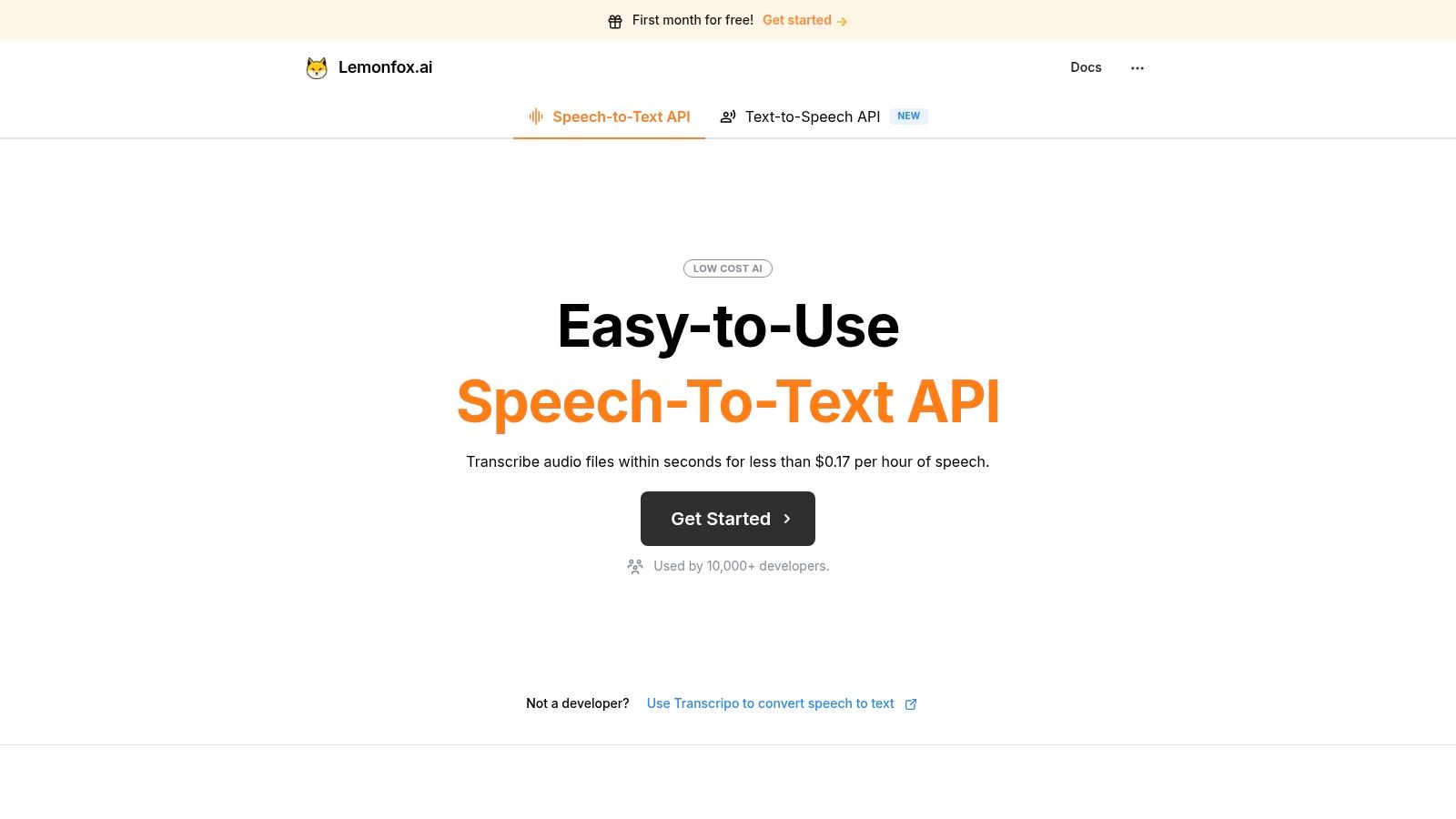
The platform is engineered for seamless integration, providing clear documentation and a developer-centric approach. For businesses and individual creators, this translates to easily implementing voiceovers for video content, developing accessibility features for applications, or creating dynamic interactive voice response (IVR) systems without a significant financial investment.
Best for: Developers and businesses looking for a high-performance, budget-friendly, and privacy-conscious text to speech API with the added benefit of world-class transcription services.
Website: https://www.lemonfox.ai
As a cornerstone of the Google Cloud Platform (GCP), Google's Text-to-Speech API is an enterprise-grade solution known for its reliability, scalability, and seamless integration within the GCP ecosystem. It stands out for its tiered voice offerings, providing developers with a spectrum of quality and cost options, from standard robotic voices to the incredibly lifelike Studio and Journey voices, which are among the most natural-sounding synthetic voices available. This makes it a strong contender for the title of best text to speech api for businesses already invested in Google's infrastructure.
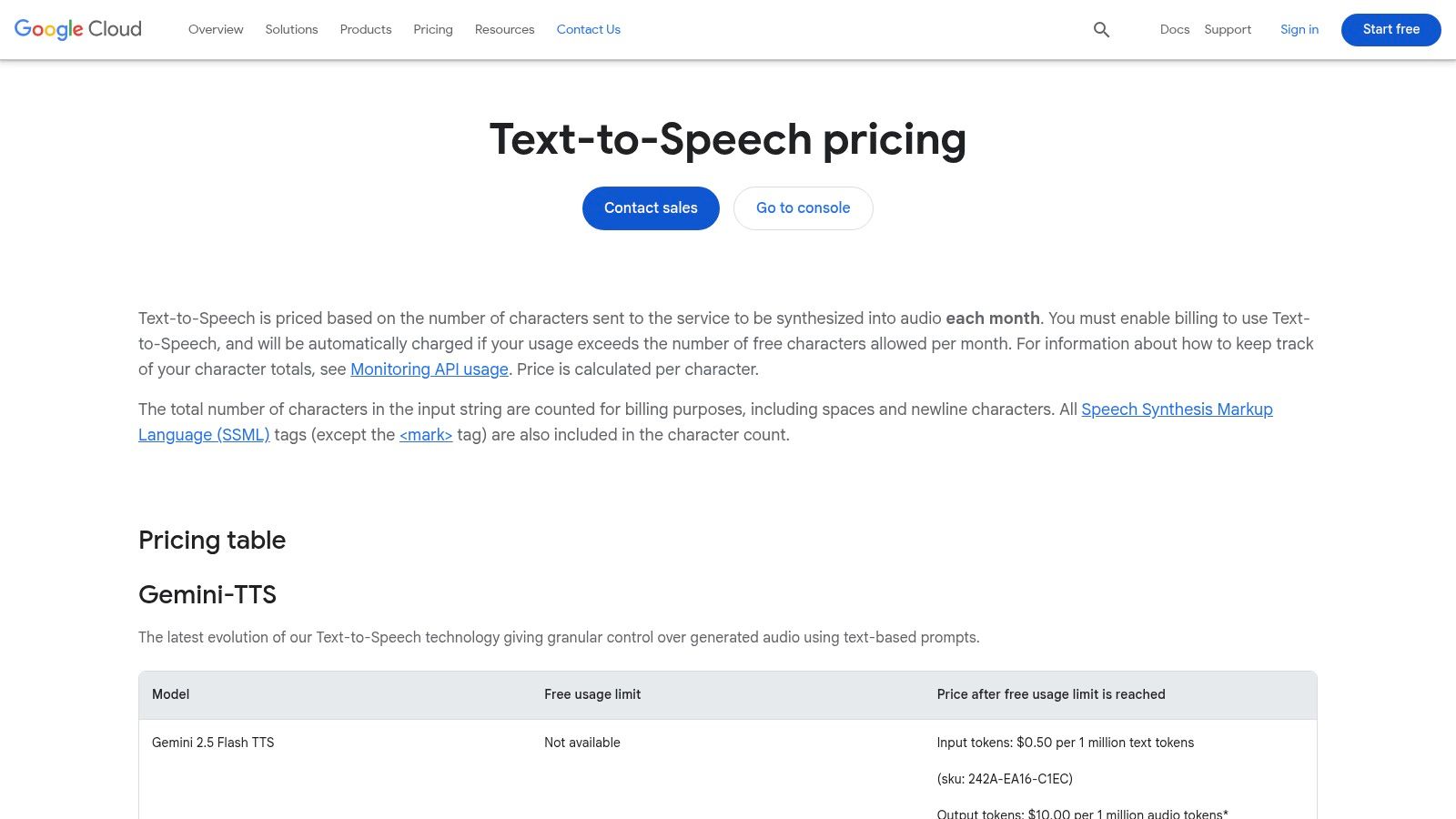
The platform is ideal for large-scale applications such as call center IVR systems, public announcement generation, and creating audio content for global audiences. Integration is straightforward for existing GCP users, leveraging familiar IAM roles and consolidated billing.
The granular, per-character pricing model is a significant advantage, allowing for precise cost control. The free tier is also generous, particularly for its Standard and WaveNet voices, making it accessible for prototyping and small projects.
Website: cloud.google.com/text-to-speech
As a core component of Amazon Web Services (AWS), Amazon Polly is an enterprise-level Text-to-Speech service designed for developers embedded in the AWS ecosystem. It excels with its distinct voice categories, offering Standard, Neural, Long-form, and advanced Generative voices. This tiered approach allows for a balance between performance and cost, making it a strong candidate for the best text to speech api for applications requiring scalability and integration with other AWS services, including support for specialized workloads through AWS GovCloud.

The platform is particularly well-suited for interactive voice response (IVR) systems, automated content creation, and accessibility solutions. Its deep integration with AWS simplifies management for existing users, leveraging shared billing, monitoring via CloudWatch, and standard AWS SDKs for implementation. The service's ability to generate Speech Marks, which provide metadata about when specific words and sentences are spoken, is a key differentiator for creating synchronized experiences like avatar animation.
Amazon Polly’s pricing is based on the number of characters processed, with clear cost tables and usage scenarios provided to help with budget estimation. The AWS Free Tier offers a generous allowance for both Standard and Neural voices, enabling developers to build and test applications with minimal initial investment.
Website: aws.amazon.com/polly/pricing/
As a core component of Microsoft's AI ecosystem, Azure AI Speech offers a powerful and highly customizable Text-to-Speech service. It is particularly well-suited for enterprises that require deep control over voice branding and deployment flexibility. The platform's standout feature is Custom Neural Voice, which allows organizations to create a unique, high-quality voice model trained on their own audio recordings, making it a leading contender for the best text to speech api for brand-centric applications.
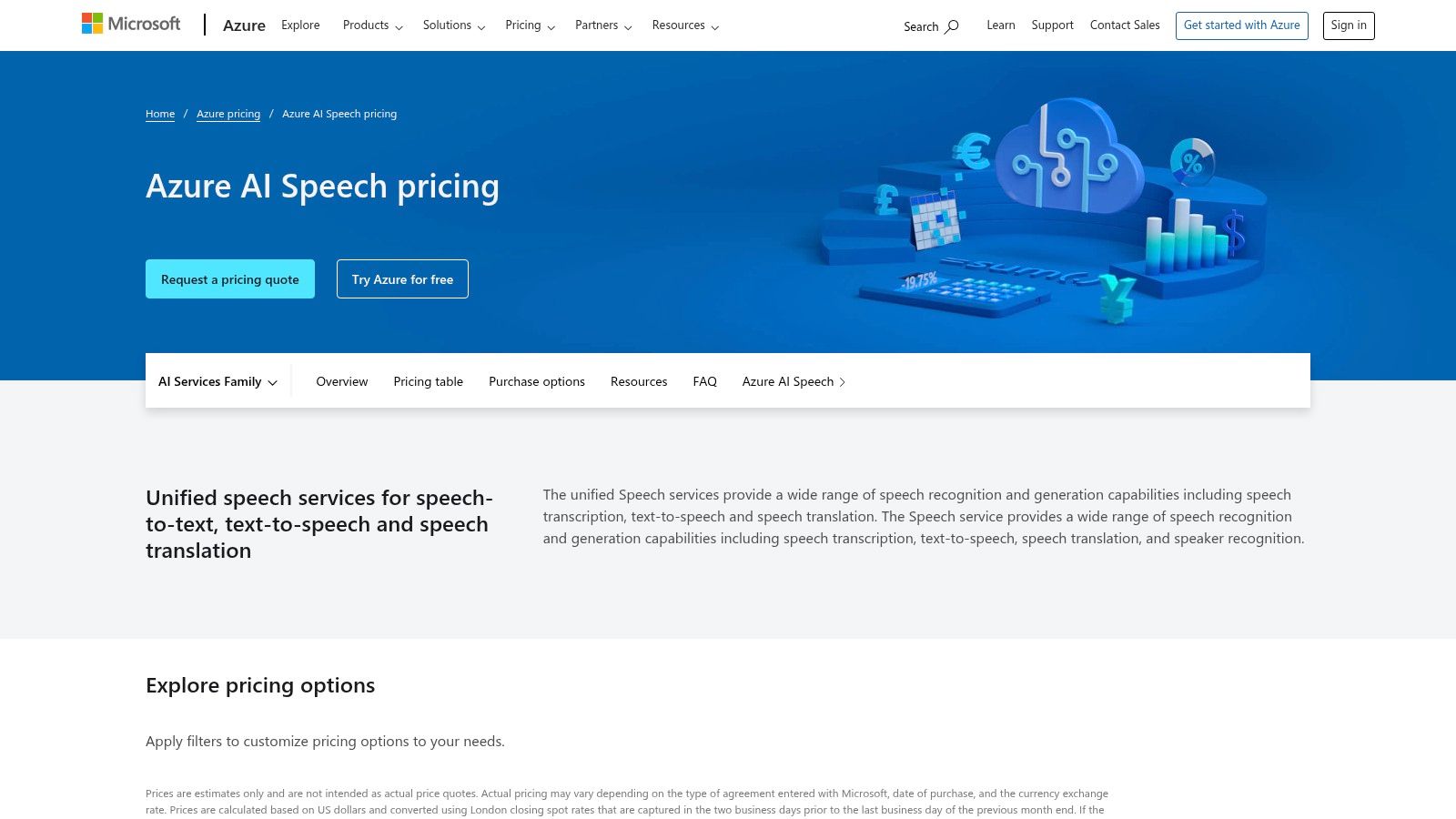
This service excels in scenarios requiring specific vocal styles, roles, or emotions, such as creating branded virtual assistants or dynamic audiobook narration. Its integration with Azure's robust enterprise controls, including security and Identity and Access Management (IAM), makes it a secure choice for large-scale deployments. The option for on-premises deployment via containers provides an additional layer of data control for sensitive applications.
Azure provides a generous free tier that includes millions of characters for its neural voices, making it highly accessible for prototyping and development. The documentation is extensive, providing clear guidance for leveraging SSML to fine-tune pitch, rate, and emotion.
Website: azure.microsoft.com/pricing/details/cognitive-services/speech-services/
Integrated directly into OpenAI's multimodal ecosystem, the Text-to-Speech (TTS) endpoint is designed for developers building real-time, interactive voice applications. It excels in low-latency streaming scenarios, making it a prime choice for conversational AI agents, dynamic narrators, and interactive voice response systems. The API offers a selection of high-quality, natural-sounding preset voices, with models optimized for either speed or fidelity, providing a simple yet powerful tool for developers already using OpenAI's other services.
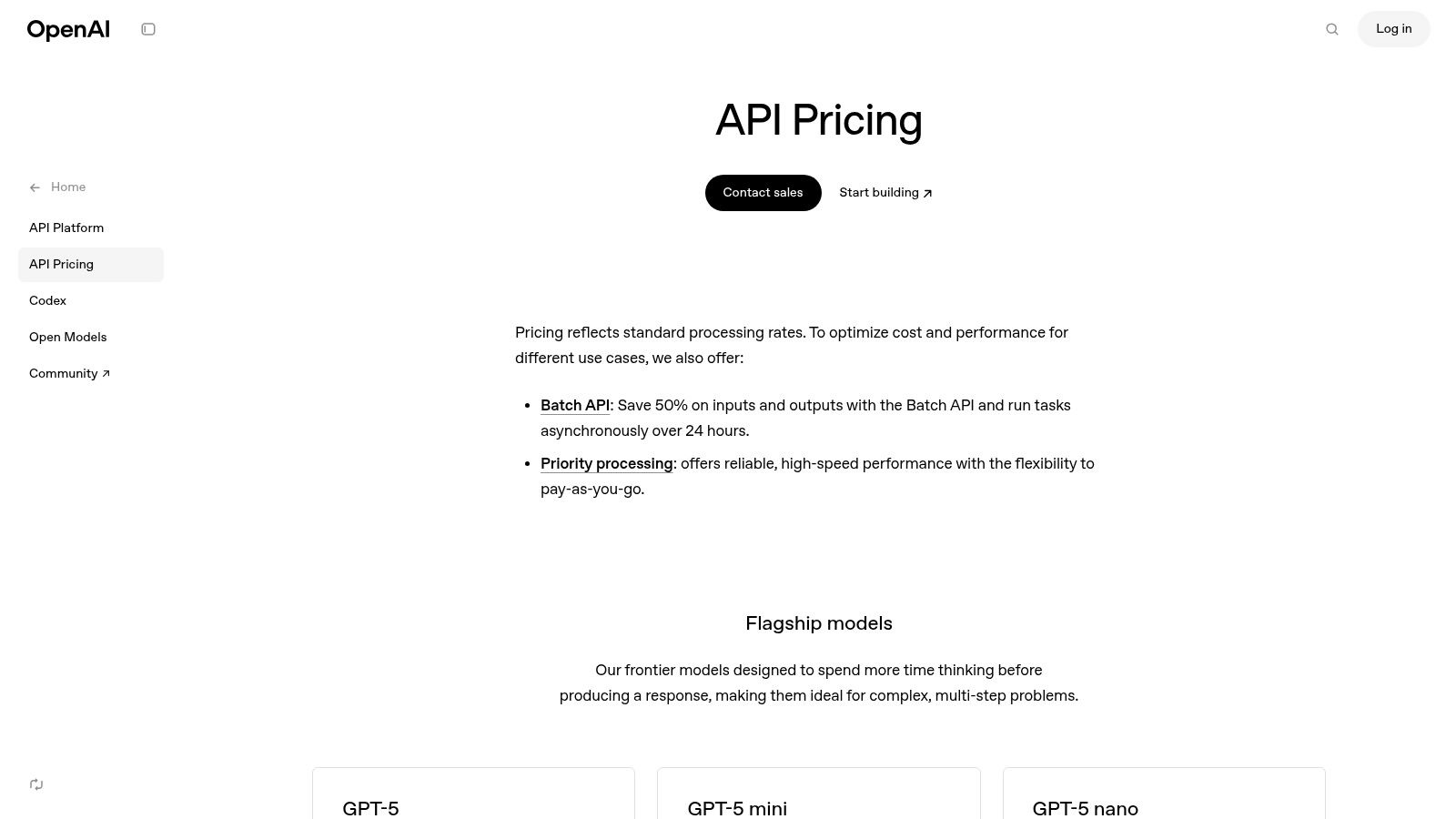
This unified platform approach simplifies development and billing, consolidating costs across services like GPT models and Whisper. For developers keen on leveraging cutting-edge models, exploring OpenAI's latest initiatives can provide valuable insights into their Text-to-Speech endpoint's capabilities. This tight integration makes it a strong candidate for the best text to speech api for projects requiring seamless speech-in/speech-out functionality.
The API's primary advantage is its straightforward implementation and focus on real-time performance, which is crucial for creating responsive user experiences. The pricing is based on a per-character model, consistent with other OpenAI offerings, allowing for predictable costs.
Website: openai.com/api/pricing
ElevenLabs has rapidly gained prominence for its developer-friendly approach and exceptionally high-quality, natural-sounding voices. Its API is particularly celebrated for its advanced voice cloning capabilities, allowing users to create digital replicas of voices with remarkable accuracy from just a few audio samples. The platform offers a well-balanced mix of quality and low-latency models, making it a powerful contender for the best text to speech api, especially for applications requiring unique or branded voices.
The API is ideal for dynamic content creation, such as real-time audiobook narration, personalized video game dialogue, and scalable voiceover production for social media. Its simple, credit-based billing system covers a suite of audio tools, including Speech-to-Speech and AI dubbing, providing a comprehensive solution for audio-centric developers.
The platform's generous free tier and clear starter plans make it easy for developers to begin experimenting and integrating the service. The well-documented API and active community support contribute to a positive developer experience, allowing for rapid implementation and iteration.
Website: elevenlabs.io/pricing/api
Play.ht offers a versatile text-to-speech API designed for creators and developers seeking a vast library of voices with expressive emotional range. Its primary differentiator is the sheer volume and diversity of its voice inventory, boasting over 700 voices across more than 120 languages and accents. This extensive selection, combined with controls for various voice styles and tones, makes it a strong contender for applications requiring nuanced audio, such as video narration, e-learning content, and character-driven stories.
The API is engineered for performance, providing low-latency streaming endpoints that are ideal for real-time conversational AI and interactive applications. With SDKs available and transparent documentation on rate limits for different subscription plans, developers can quickly integrate and scale their projects. This makes it a compelling choice for those prioritizing voice variety and real-time audio generation.
Play.ht’s tiered plan structure, which includes a free option, allows users to start small and scale up as their needs grow. However, API access is a premium feature, so developers must select a subscription plan that specifically includes it.
Website: play.ht/text-to-speech-api
A veteran in the enterprise AI space, IBM Watson offers a Text-to-Speech service that prioritizes security, compliance, and deployment flexibility. Its standout feature is the option for an embeddable, containerized library, allowing businesses to run TTS on-premises or in a private cloud. This makes it a leading text to speech api for industries with stringent data privacy requirements, such as finance and healthcare, by ensuring sensitive data never leaves their controlled environment.
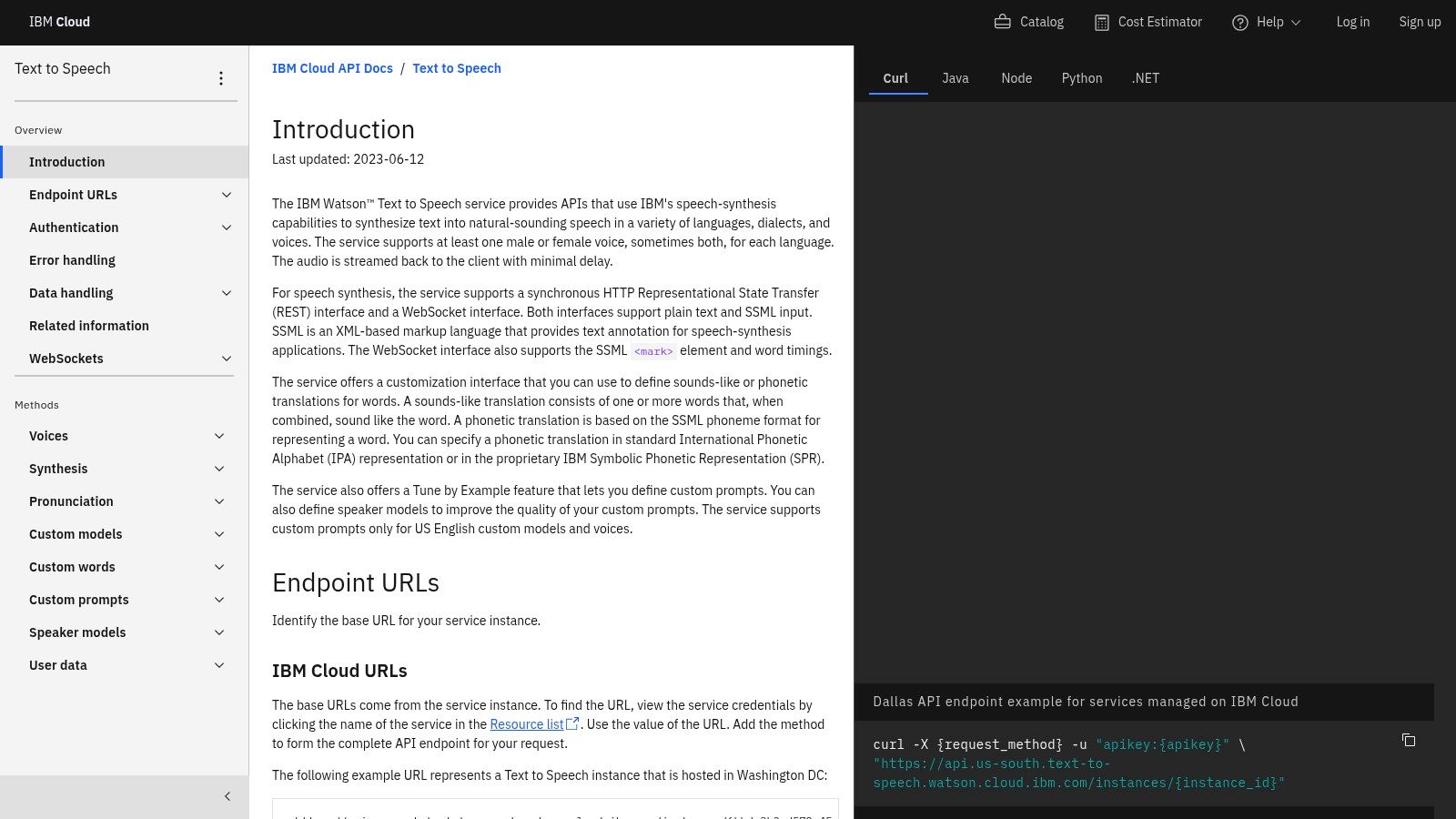
The platform is designed for enterprise-grade applications, including customer service bots, interactive voice response (IVR) systems, and internal corporate training modules. Watson provides robust support for SSML, custom lexicons, and a variety of audio formats, giving developers fine-grained control over the final speech output for a more tailored user experience.
IBM’s dual offering of a cloud API and an embeddable library caters to different architectural needs. The cloud version offers typical pay-as-you-go pricing with a free tier, while the embeddable library uses a subscription model, providing cost predictability for high-volume, private deployments.
Website: cloud.ibm.com/apidocs/text-to-speech
WellSaid Labs offers a boutique API experience focused on providing exceptionally high-quality, consistent voice avatars for commercial and enterprise content production. Instead of offering hundreds of voices with varying quality, their platform provides a curated selection of production-ready "Voice Avatars" that are ideal for brand-aligned content like marketing materials, e-learning modules, and corporate training. Their approach makes them a strong candidate for the best text to speech api for teams that prioritize brand voice consistency and premium audio output.
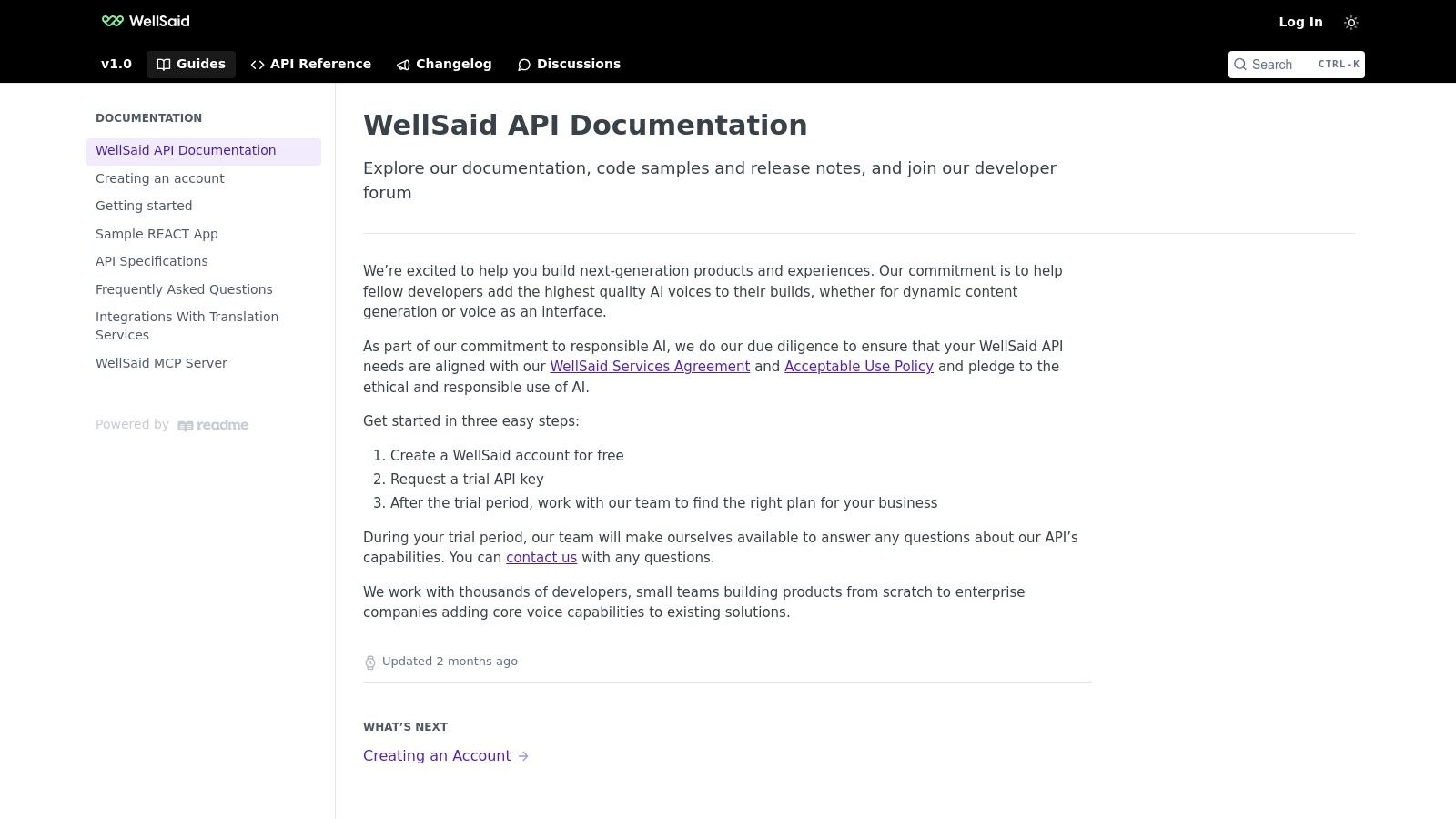
The service is distinguished by its guided, human-supported onboarding process. The 14-day API trial provides access to all voice avatars for testing, after which the team works with you to design a custom plan. This high-touch model is geared towards businesses needing a reliable, scalable solution with direct support.
WellSaid Labs focuses on a premium, supported experience rather than a self-serve, pay-as-you-go model. The API is best suited for established production workflows where voice quality and consistency are non-negotiable.
Website: docs.wellsaidlabs.com/docs
ReadSpeaker speechCloud API is a powerful cloud-based solution with a strong foothold in the education, IVR/PBX, and web accessibility markets. It distinguishes itself with a vast portfolio of over 200 voices across more than 50 languages, providing enterprise-grade support and specialized features tailored for these sectors. The platform is designed for developers who need reliable, high-quality audio for applications that require precise timing and custom pronunciation, making it a solid choice for specialized projects.
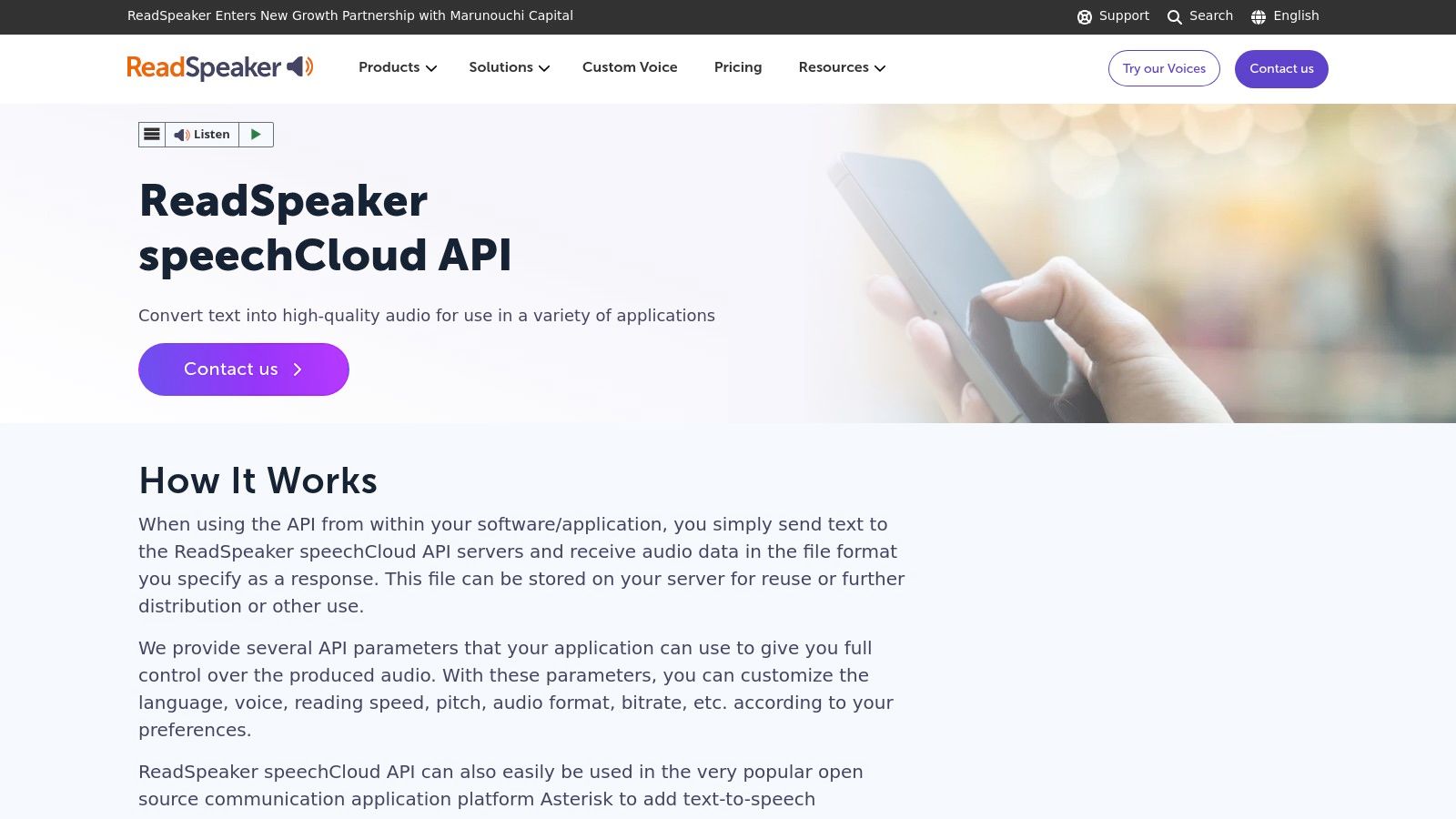
This API is particularly well-suited for creating accessible educational content, powering interactive voice response systems, and enabling large-scale, pre-produced audio file generation. Its inclusion of timing information for word and sentence highlighting is a key feature for learning and accessibility applications, setting it apart from more generalized competitors.
ReadSpeaker offers robust control over audio output through SSML and custom lexicons, allowing developers to fine-tune pronunciations for specific terminology. The credit-based system provides a flexible way to purchase API usage, though it requires direct contact with their sales team for specific pricing details.
Website: www.readspeaker.com/solutions/speech-production/readspeaker-speechcloud-api/
NVIDIA Riva offers a distinct approach, providing GPU-accelerated microservices for text-to-speech that can be deployed anywhere, from on-premises servers to the cloud or edge devices. This self-hosted model grants organizations complete control over their data, making it a powerful choice for industries with strict privacy and security requirements, such as finance and healthcare. Instead of a typical pay-per-character API, Riva is a full-stack platform designed for high-performance, real-time synthesis, which is a key differentiator for applications demanding minimal latency.
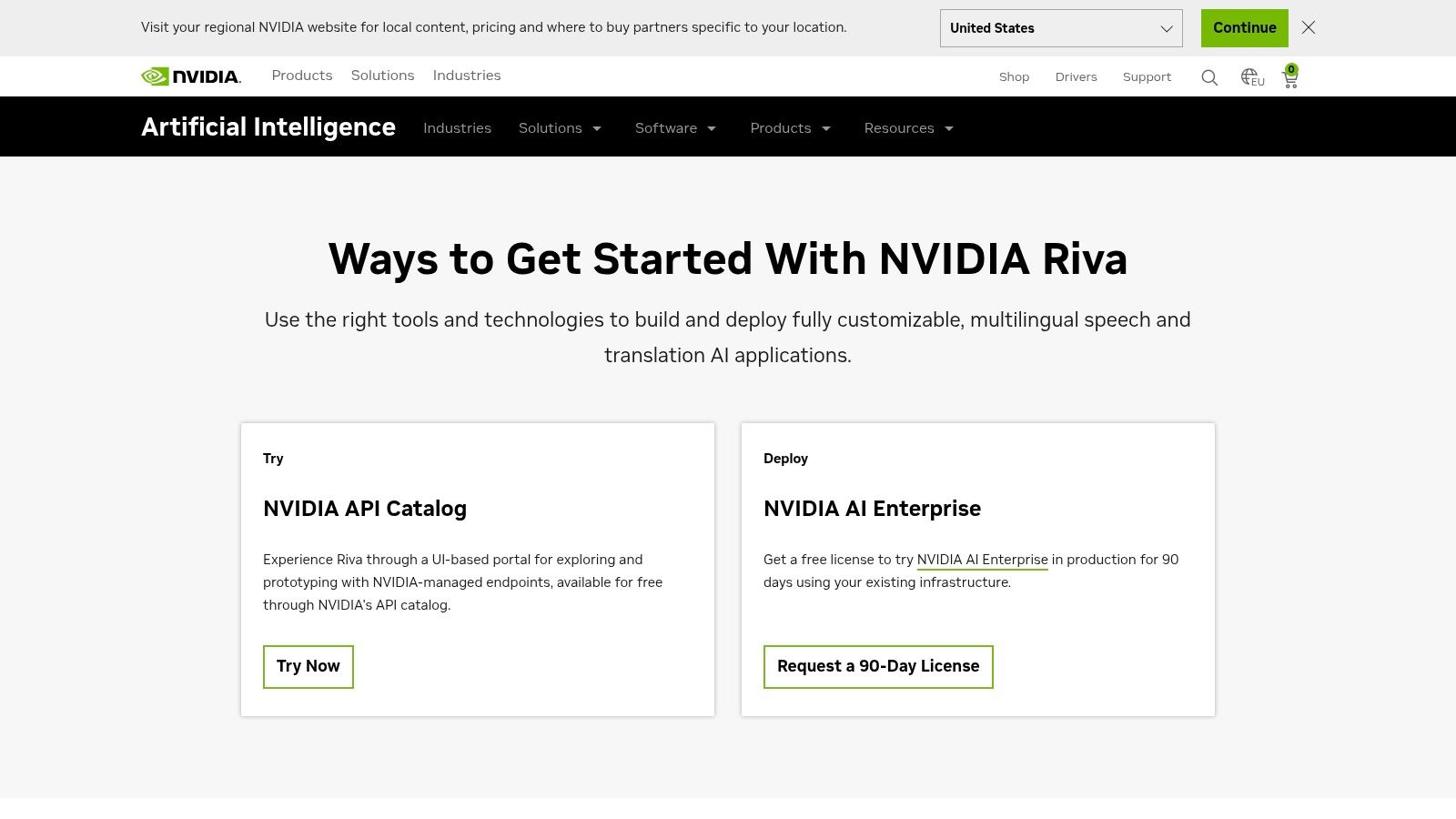
The platform is ideal for enterprise-level, interactive applications like real-time conversational AI, in-car voice assistants, and offline-capable devices. Deployment through Docker containers simplifies setup on compatible hardware, though it requires more infrastructure management than a standard SaaS API. This makes it a contender for the best text to speech api for teams needing maximum control and performance.
Riva's architecture is built for customization and scalability, backed by NVIDIA's AI Enterprise support. This ensures businesses can fine-tune models and receive expert assistance, but it comes at the cost of requiring specialized GPU infrastructure and an enterprise license.
Website: www.nvidia.com/en-eu/ai-data-science/products/riva/get-started/
For developers seeking ultimate control and flexibility, Hugging Face Inference Endpoints offers a unique approach. Instead of a pre-packaged SaaS offering, it provides a managed platform to deploy open-source Text-to-Speech models on dedicated, autoscaling infrastructure. This allows you to choose from a vast library of models like VITS, Bark, and XTTS, or even deploy your own custom-trained model, making it a powerful contender for the best text to speech api for specialized and research-heavy projects.
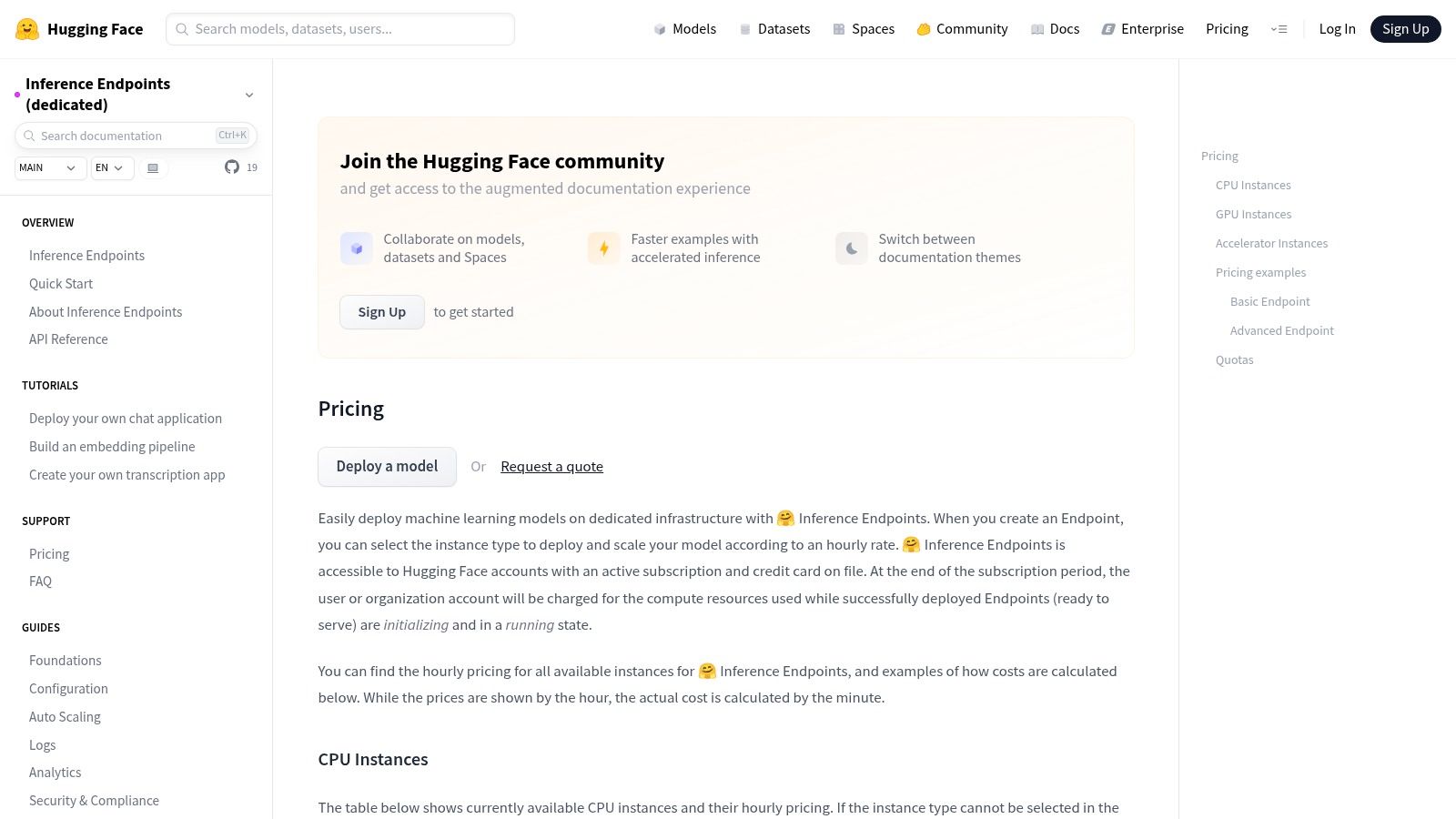
The platform is ideal for applications requiring specific voice characteristics not found in commercial APIs or for teams that need to maintain tight control over the model and its underlying hardware. It abstracts away the complexity of MLOps, providing a simple REST API interface for production workloads with your chosen CPU or GPU instances.
The pricing model is based on hourly compute usage with per-minute billing, which is transparent and predictable for consistent workloads. While you are responsible for selecting a high-quality model, the one-click deployment and managed environment significantly lower the barrier to entry for using state-of-the-art open-source technology.
Website: huggingface.co/docs/inference-endpoints/pricing
| Service | Core Features / Capabilities | User Experience / Quality ★★★★☆ | Value Proposition 💰 | Target Audience 👥 | Unique Selling Points ✨ | Price Points 💰 |
|---|---|---|---|---|---|---|
| Lemonfox.ai 🏆 | Speech-to-Text & Text-to-Speech, 100+ languages, speaker recognition, EU-based API | High accuracy, minimal latency, privacy-first | Ultra-affordable: <$0.17/hr, free 30h trial | Developers & businesses | Combined STT & TTS, immediate data deletion, Whisper large-v3 AI | <$0.17/hr speech transcription |
| Google Cloud Text-to-Speech | Neural/WaveNet voices, SSML, wide language support | Mature voices, enterprise reliability | Transparent, granular pricing | Google Cloud users, enterprises | Studio/Journey voices, IAM integration | Per character, varies by voice |
| Amazon Polly (AWS) | Standard & Neural voices, Speech Marks, GovCloud | Rich metadata for sync, free tier credits | Clear cost examples, free tier | AWS customers, gov workloads | Speech Marks for precise timing | Varies by voice class |
| Microsoft Azure AI Speech | Neural voices, custom voice training, container support | Enterprise-grade, flexible deployments | Free monthly tier for prototyping | Enterprises, developers | Custom Neural Voice, containerized deployment | Contact sales; variable pricing |
| OpenAI Text-to-Speech | Streaming low-latency TTS, preset voices | Simple API, good for real-time apps | Unified billing across OpenAI services | Real-time apps, developers | Streaming API, evolving voice inventory | Usage-based, evolving pricing |
| ElevenLabs Text-to-Speech API | High-quality, voice cloning, credit-based billing | Balanced latency & quality, easy starter plans | Generous free tier, developer-focused | Developers, creators | Voice cloning with commercial license | Credit system, tiered plans |
| Play.ht Text-to-Speech API | 700+ voices, 120+ languages, expressive styles | Streaming support, SDKs available | Range of plans hobbyist to enterprise | Broad, hobbyists to enterprises | Extensive voice styles & emotions | Varied by subscription |
| IBM Watson Text-to-Speech | SSML, lexicons, embeddable on-prem option | Enterprise stability, privacy-focused | Subscription pricing, embeddable option | Enterprises with privacy needs | On-prem/hybrid cloud deployments | Subscription-based, variable |
| WellSaid Labs API | High-quality voice avatars, onboarding support | Consistent voice quality, trial with support | Custom pricing post-trial | Commercial content producers | Curated voices, strong customer support | Custom, after trial |
| ReadSpeaker speechCloud API | 200+ voices, 50+ languages, timing metadata | Focus on education/accessibility use | Credit-based, requires sales contact | Education, IVR, accessibility | Pre-produced audio at scale | Contact sales |
| NVIDIA Riva (TTS microservice) | GPU-accelerated, on-prem/edge, model customization | Enterprise-grade, low latency | Requires GPU infra & licensing | Regulated industries, enterprises | Private/offline TTS, NVIDIA AI Enterprise support | Enterprise licensing |
| Hugging Face Inference Endpoints | Open-source TTS models, autoscaling, CPU/GPU options | Flexible model choice, managed deployment | Transparent hourly pricing | Developers, ML practitioners | Bring-your-own-model, cloud flexibility | Hourly instance pricing |
Navigating the landscape of TTS APIs can feel overwhelming, but as we've explored, the diversity of options is a significant advantage for developers and businesses. The journey to finding the best text to speech api isn't about identifying a single, universally superior tool. Instead, it’s about a careful and strategic alignment of an API's strengths with your project's unique demands.
The key takeaway from our detailed comparison is that the market is segmented by specific needs. There is no one-size-fits-all solution. Your final decision should be a deliberate trade-off between voice quality, latency, feature set, cost, and ease of integration.
To simplify your choice, let's categorize the contenders based on their core strengths:
Before you commit to a long-term integration, it is crucial to perform hands-on testing. Don't just rely on marketing demos.
Ultimately, the right API is the one that empowers you to build a better product faster and more efficiently. By methodically evaluating your options against your specific use case, you can confidently select a partner that will not only meet your current needs but also support your future growth.
Ready to experience high-quality, developer-friendly speech technology without the high costs of legacy providers? Explore Lemonfox.ai, which offers both top-tier Text-to-Speech and Speech-to-Text APIs at a fraction of the price. Sign up for free at Lemonfox.ai and see how simple and affordable building with voice can be.